Research Proposal: Smoking Cessation for UK Children and Adolescents
VerifiedAdded on 2020/01/28
|7
|1404
|43
Project
AI Summary
This research proposal critically evaluates smoking cessation for children and adolescents in the UK. The proposal includes a title, justification, literature review, rationale, aims, objectives, research questions, and detailed research methodology. It outlines the use of interpretivism philosophy, inductive approach, and descriptive design with qualitative research techniques. Data collection methods include primary (questionnaires) and secondary sources (books, journals, articles), with a sample size of 20 healthcare professionals. The study also addresses ethical considerations and presents a research action plan using a Gantt chart. The aim is to understand the concepts and impacts of smoking cessation, analyze essential methods, and suggest ways to reduce smoking rates. The proposal concludes with a comprehensive list of references.
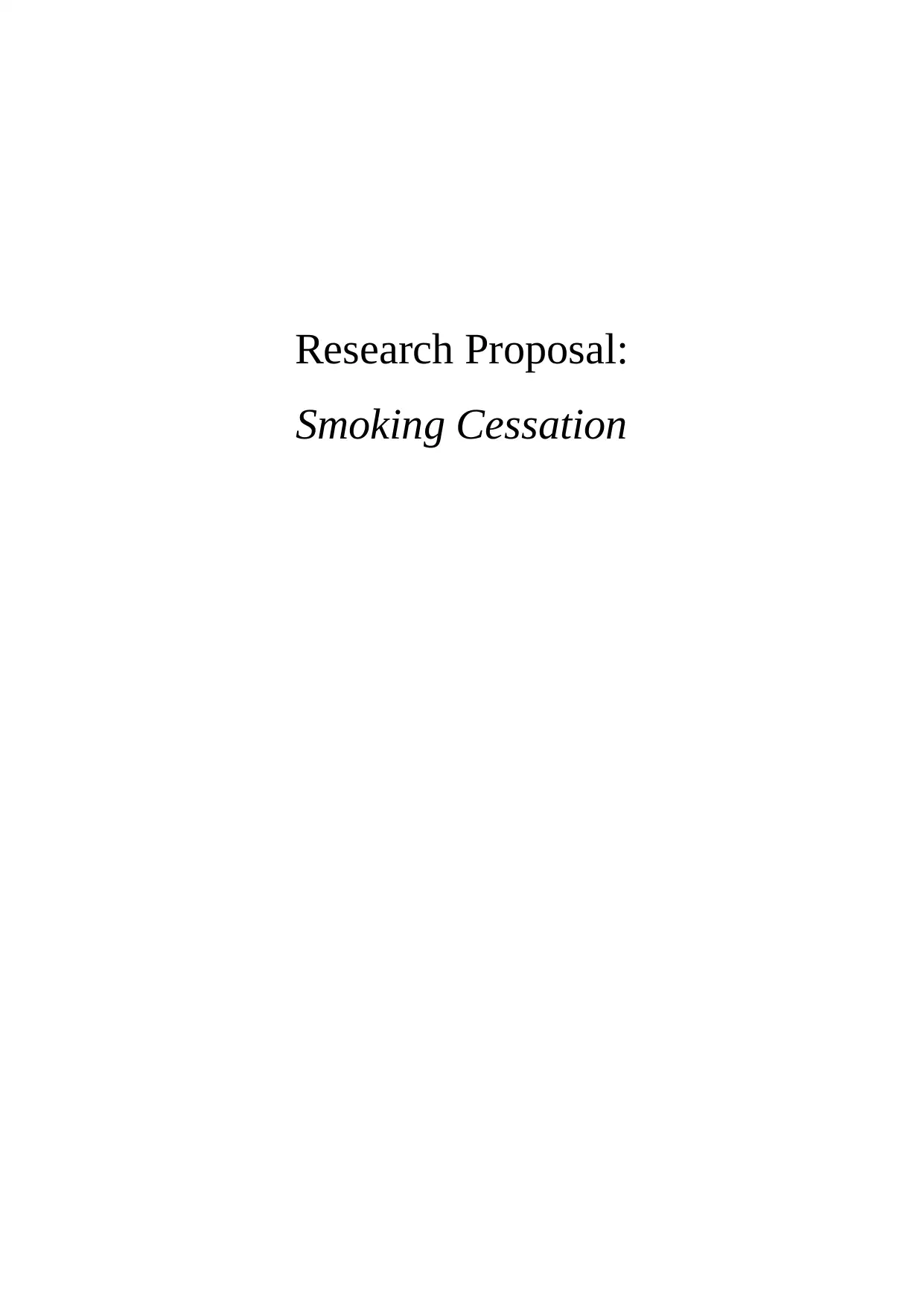
Research Proposal:
Smoking Cessation
Smoking Cessation
Paraphrase This Document
Need a fresh take? Get an instant paraphrase of this document with our AI Paraphraser

Table of Contents
1. Title..............................................................................................................................................4
2. Justification of the project............................................................................................................4
3. Literature Review........................................................................................................................4
4. Rationale of the study..................................................................................................................4
5. Aims, Objectives and research questions. ...................................................................................4
6. Research Methodology................................................................................................................5
7. Ethical considerations..................................................................................................................5
8. Research action plan....................................................................................................................5
REFERENCES.....................................................................................................................................7
1. Title..............................................................................................................................................4
2. Justification of the project............................................................................................................4
3. Literature Review........................................................................................................................4
4. Rationale of the study..................................................................................................................4
5. Aims, Objectives and research questions. ...................................................................................4
6. Research Methodology................................................................................................................5
7. Ethical considerations..................................................................................................................5
8. Research action plan....................................................................................................................5
REFERENCES.....................................................................................................................................7

Index of Tables
Table 1: Gantt chart..............................................................................................................................5
Table 1: Gantt chart..............................................................................................................................5
⊘ This is a preview!⊘
Do you want full access?
Subscribe today to unlock all pages.

Trusted by 1+ million students worldwide
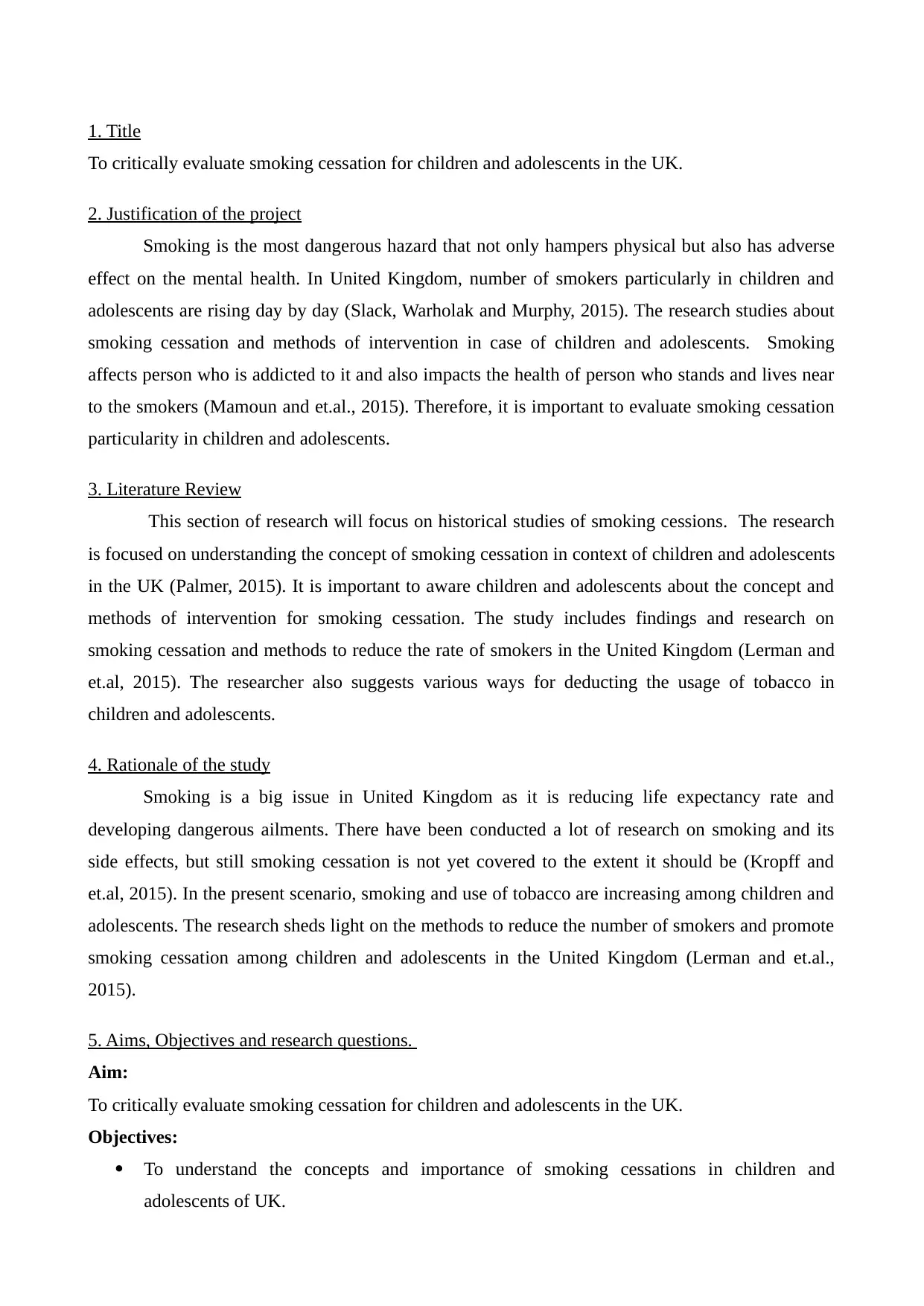
1. Title
To critically evaluate smoking cessation for children and adolescents in the UK.
2. Justification of the project
Smoking is the most dangerous hazard that not only hampers physical but also has adverse
effect on the mental health. In United Kingdom, number of smokers particularly in children and
adolescents are rising day by day (Slack, Warholak and Murphy, 2015). The research studies about
smoking cessation and methods of intervention in case of children and adolescents. Smoking
affects person who is addicted to it and also impacts the health of person who stands and lives near
to the smokers (Mamoun and et.al., 2015). Therefore, it is important to evaluate smoking cessation
particularity in children and adolescents.
3. Literature Review
This section of research will focus on historical studies of smoking cessions. The research
is focused on understanding the concept of smoking cessation in context of children and adolescents
in the UK (Palmer, 2015). It is important to aware children and adolescents about the concept and
methods of intervention for smoking cessation. The study includes findings and research on
smoking cessation and methods to reduce the rate of smokers in the United Kingdom (Lerman and
et.al, 2015). The researcher also suggests various ways for deducting the usage of tobacco in
children and adolescents.
4. Rationale of the study
Smoking is a big issue in United Kingdom as it is reducing life expectancy rate and
developing dangerous ailments. There have been conducted a lot of research on smoking and its
side effects, but still smoking cessation is not yet covered to the extent it should be (Kropff and
et.al, 2015). In the present scenario, smoking and use of tobacco are increasing among children and
adolescents. The research sheds light on the methods to reduce the number of smokers and promote
smoking cessation among children and adolescents in the United Kingdom (Lerman and et.al.,
2015).
5. Aims, Objectives and research questions.
Aim:
To critically evaluate smoking cessation for children and adolescents in the UK.
Objectives:
To understand the concepts and importance of smoking cessations in children and
adolescents of UK.
To critically evaluate smoking cessation for children and adolescents in the UK.
2. Justification of the project
Smoking is the most dangerous hazard that not only hampers physical but also has adverse
effect on the mental health. In United Kingdom, number of smokers particularly in children and
adolescents are rising day by day (Slack, Warholak and Murphy, 2015). The research studies about
smoking cessation and methods of intervention in case of children and adolescents. Smoking
affects person who is addicted to it and also impacts the health of person who stands and lives near
to the smokers (Mamoun and et.al., 2015). Therefore, it is important to evaluate smoking cessation
particularity in children and adolescents.
3. Literature Review
This section of research will focus on historical studies of smoking cessions. The research
is focused on understanding the concept of smoking cessation in context of children and adolescents
in the UK (Palmer, 2015). It is important to aware children and adolescents about the concept and
methods of intervention for smoking cessation. The study includes findings and research on
smoking cessation and methods to reduce the rate of smokers in the United Kingdom (Lerman and
et.al, 2015). The researcher also suggests various ways for deducting the usage of tobacco in
children and adolescents.
4. Rationale of the study
Smoking is a big issue in United Kingdom as it is reducing life expectancy rate and
developing dangerous ailments. There have been conducted a lot of research on smoking and its
side effects, but still smoking cessation is not yet covered to the extent it should be (Kropff and
et.al, 2015). In the present scenario, smoking and use of tobacco are increasing among children and
adolescents. The research sheds light on the methods to reduce the number of smokers and promote
smoking cessation among children and adolescents in the United Kingdom (Lerman and et.al.,
2015).
5. Aims, Objectives and research questions.
Aim:
To critically evaluate smoking cessation for children and adolescents in the UK.
Objectives:
To understand the concepts and importance of smoking cessations in children and
adolescents of UK.
Paraphrase This Document
Need a fresh take? Get an instant paraphrase of this document with our AI Paraphraser
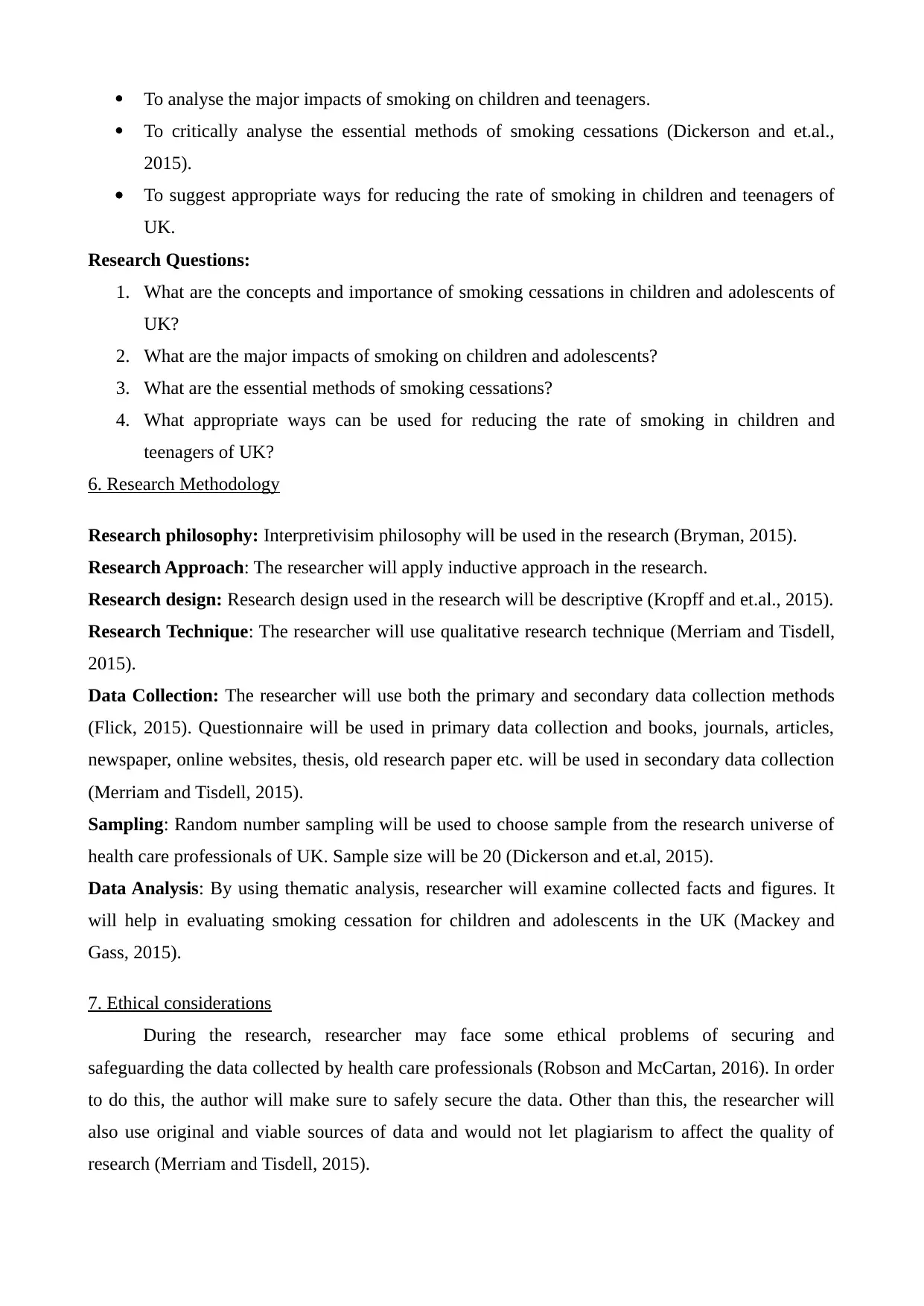
To analyse the major impacts of smoking on children and teenagers.
To critically analyse the essential methods of smoking cessations (Dickerson and et.al.,
2015).
To suggest appropriate ways for reducing the rate of smoking in children and teenagers of
UK.
Research Questions:
1. What are the concepts and importance of smoking cessations in children and adolescents of
UK?
2. What are the major impacts of smoking on children and adolescents?
3. What are the essential methods of smoking cessations?
4. What appropriate ways can be used for reducing the rate of smoking in children and
teenagers of UK?
6. Research Methodology
Research philosophy: Interpretivisim philosophy will be used in the research (Bryman, 2015).
Research Approach: The researcher will apply inductive approach in the research.
Research design: Research design used in the research will be descriptive (Kropff and et.al., 2015).
Research Technique: The researcher will use qualitative research technique (Merriam and Tisdell,
2015).
Data Collection: The researcher will use both the primary and secondary data collection methods
(Flick, 2015). Questionnaire will be used in primary data collection and books, journals, articles,
newspaper, online websites, thesis, old research paper etc. will be used in secondary data collection
(Merriam and Tisdell, 2015).
Sampling: Random number sampling will be used to choose sample from the research universe of
health care professionals of UK. Sample size will be 20 (Dickerson and et.al, 2015).
Data Analysis: By using thematic analysis, researcher will examine collected facts and figures. It
will help in evaluating smoking cessation for children and adolescents in the UK (Mackey and
Gass, 2015).
7. Ethical considerations
During the research, researcher may face some ethical problems of securing and
safeguarding the data collected by health care professionals (Robson and McCartan, 2016). In order
to do this, the author will make sure to safely secure the data. Other than this, the researcher will
also use original and viable sources of data and would not let plagiarism to affect the quality of
research (Merriam and Tisdell, 2015).
To critically analyse the essential methods of smoking cessations (Dickerson and et.al.,
2015).
To suggest appropriate ways for reducing the rate of smoking in children and teenagers of
UK.
Research Questions:
1. What are the concepts and importance of smoking cessations in children and adolescents of
UK?
2. What are the major impacts of smoking on children and adolescents?
3. What are the essential methods of smoking cessations?
4. What appropriate ways can be used for reducing the rate of smoking in children and
teenagers of UK?
6. Research Methodology
Research philosophy: Interpretivisim philosophy will be used in the research (Bryman, 2015).
Research Approach: The researcher will apply inductive approach in the research.
Research design: Research design used in the research will be descriptive (Kropff and et.al., 2015).
Research Technique: The researcher will use qualitative research technique (Merriam and Tisdell,
2015).
Data Collection: The researcher will use both the primary and secondary data collection methods
(Flick, 2015). Questionnaire will be used in primary data collection and books, journals, articles,
newspaper, online websites, thesis, old research paper etc. will be used in secondary data collection
(Merriam and Tisdell, 2015).
Sampling: Random number sampling will be used to choose sample from the research universe of
health care professionals of UK. Sample size will be 20 (Dickerson and et.al, 2015).
Data Analysis: By using thematic analysis, researcher will examine collected facts and figures. It
will help in evaluating smoking cessation for children and adolescents in the UK (Mackey and
Gass, 2015).
7. Ethical considerations
During the research, researcher may face some ethical problems of securing and
safeguarding the data collected by health care professionals (Robson and McCartan, 2016). In order
to do this, the author will make sure to safely secure the data. Other than this, the researcher will
also use original and viable sources of data and would not let plagiarism to affect the quality of
research (Merriam and Tisdell, 2015).
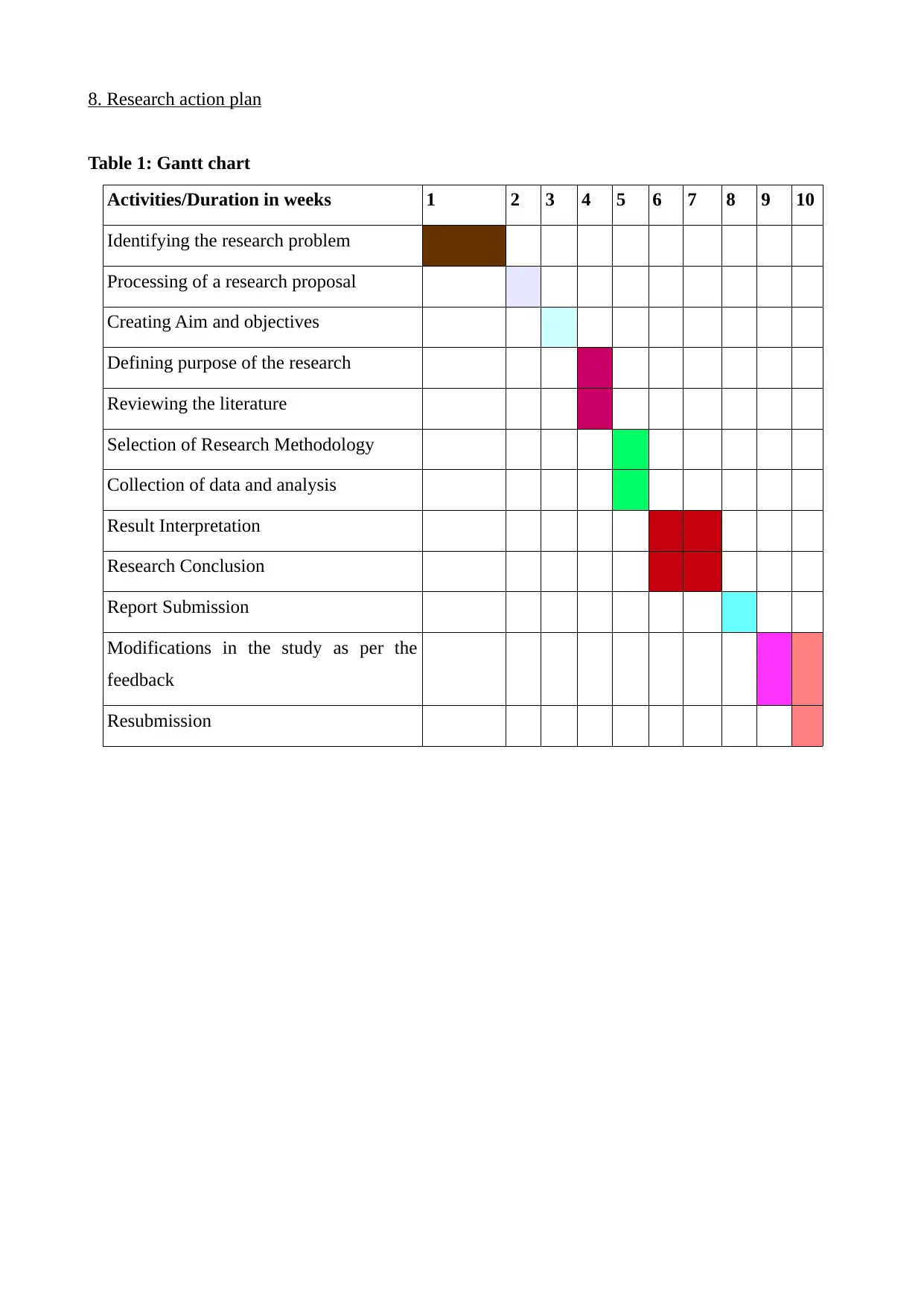
8. Research action plan
Table 1: Gantt chart
Activities/Duration in weeks 1 2 3 4 5 6 7 8 9 10
Identifying the research problem
Processing of a research proposal
Creating Aim and objectives
Defining purpose of the research
Reviewing the literature
Selection of Research Methodology
Collection of data and analysis
Result Interpretation
Research Conclusion
Report Submission
Modifications in the study as per the
feedback
Resubmission
Table 1: Gantt chart
Activities/Duration in weeks 1 2 3 4 5 6 7 8 9 10
Identifying the research problem
Processing of a research proposal
Creating Aim and objectives
Defining purpose of the research
Reviewing the literature
Selection of Research Methodology
Collection of data and analysis
Result Interpretation
Research Conclusion
Report Submission
Modifications in the study as per the
feedback
Resubmission
⊘ This is a preview!⊘
Do you want full access?
Subscribe today to unlock all pages.

Trusted by 1+ million students worldwide
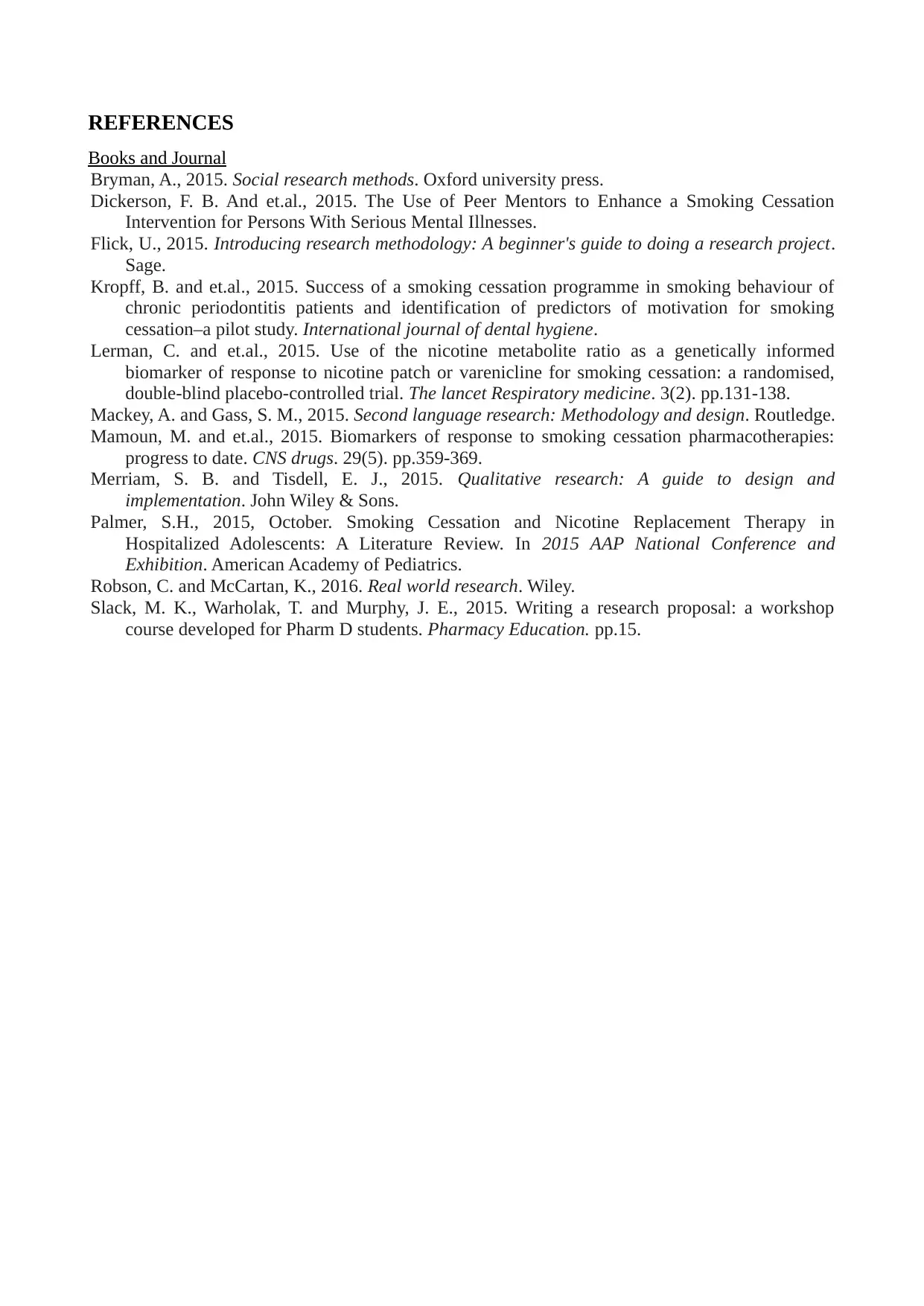
REFERENCES
Books and Journal
Bryman, A., 2015. Social research methods. Oxford university press.
Dickerson, F. B. And et.al., 2015. The Use of Peer Mentors to Enhance a Smoking Cessation
Intervention for Persons With Serious Mental Illnesses.
Flick, U., 2015. Introducing research methodology: A beginner's guide to doing a research project.
Sage.
Kropff, B. and et.al., 2015. Success of a smoking cessation programme in smoking behaviour of
chronic periodontitis patients and identification of predictors of motivation for smoking
cessation–a pilot study. International journal of dental hygiene.
Lerman, C. and et.al., 2015. Use of the nicotine metabolite ratio as a genetically informed
biomarker of response to nicotine patch or varenicline for smoking cessation: a randomised,
double-blind placebo-controlled trial. The lancet Respiratory medicine. 3(2). pp.131-138.
Mackey, A. and Gass, S. M., 2015. Second language research: Methodology and design. Routledge.
Mamoun, M. and et.al., 2015. Biomarkers of response to smoking cessation pharmacotherapies:
progress to date. CNS drugs. 29(5). pp.359-369.
Merriam, S. B. and Tisdell, E. J., 2015. Qualitative research: A guide to design and
implementation. John Wiley & Sons.
Palmer, S.H., 2015, October. Smoking Cessation and Nicotine Replacement Therapy in
Hospitalized Adolescents: A Literature Review. In 2015 AAP National Conference and
Exhibition. American Academy of Pediatrics.
Robson, C. and McCartan, K., 2016. Real world research. Wiley.
Slack, M. K., Warholak, T. and Murphy, J. E., 2015. Writing a research proposal: a workshop
course developed for Pharm D students. Pharmacy Education. pp.15.
Books and Journal
Bryman, A., 2015. Social research methods. Oxford university press.
Dickerson, F. B. And et.al., 2015. The Use of Peer Mentors to Enhance a Smoking Cessation
Intervention for Persons With Serious Mental Illnesses.
Flick, U., 2015. Introducing research methodology: A beginner's guide to doing a research project.
Sage.
Kropff, B. and et.al., 2015. Success of a smoking cessation programme in smoking behaviour of
chronic periodontitis patients and identification of predictors of motivation for smoking
cessation–a pilot study. International journal of dental hygiene.
Lerman, C. and et.al., 2015. Use of the nicotine metabolite ratio as a genetically informed
biomarker of response to nicotine patch or varenicline for smoking cessation: a randomised,
double-blind placebo-controlled trial. The lancet Respiratory medicine. 3(2). pp.131-138.
Mackey, A. and Gass, S. M., 2015. Second language research: Methodology and design. Routledge.
Mamoun, M. and et.al., 2015. Biomarkers of response to smoking cessation pharmacotherapies:
progress to date. CNS drugs. 29(5). pp.359-369.
Merriam, S. B. and Tisdell, E. J., 2015. Qualitative research: A guide to design and
implementation. John Wiley & Sons.
Palmer, S.H., 2015, October. Smoking Cessation and Nicotine Replacement Therapy in
Hospitalized Adolescents: A Literature Review. In 2015 AAP National Conference and
Exhibition. American Academy of Pediatrics.
Robson, C. and McCartan, K., 2016. Real world research. Wiley.
Slack, M. K., Warholak, T. and Murphy, J. E., 2015. Writing a research proposal: a workshop
course developed for Pharm D students. Pharmacy Education. pp.15.
1 out of 7
Related Documents
Your All-in-One AI-Powered Toolkit for Academic Success.
+13062052269
info@desklib.com
Available 24*7 on WhatsApp / Email
![[object Object]](/_next/static/media/star-bottom.7253800d.svg)
Unlock your academic potential
Copyright © 2020–2025 A2Z Services. All Rights Reserved. Developed and managed by ZUCOL.





